Inside the New Zealand Industry
Hello from just about as far away from Chicago as I’ve ever been: New Zealand. Been here almost a week, visiting growers and retailers and getting to know a little bit about the industry.
I was invited down here by grower Andrew Tayler, second-generation co-owner of Rainbow Park Nursery and Rainbow Trees in the colorfully named town of Ramarama, near Auckland, New Zealand’s biggest city. The country’s association, NGINZ (Nursery & Garden Industry New Zealand) has its annual meeting this month, and Andrew, a fan of Acres Online, thought I might make an interesting speaker. Anyway, the result is a week exploring the industry and culture of this unique country, best known to outsiders for bungy jumping and Lord of the Rings.
The country
Yes, it’s as stunning as everyone says, although not all of it is wild, exotic and mountainous. Auckland, where I spent Saturday through Tuesday, is more like rural England, all rolling hills and pastures separated by hedgerows. I stayed on the nursery property with Andrew’s parents, Peter and Jane (below). The view from their backyard is as postcard as it gets.
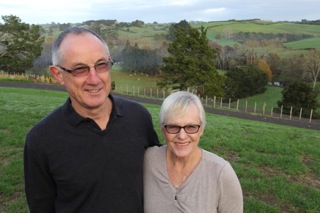
The city of Auckland itself might be best known for sailboats. The America’s Cup has sailed from here, as have round-the-world racers. They say New Zealand has more sheep than humans; I think it has more sailboats than sheep, judging from the ferry ride across the bay for lunch.
New Zealand is two islands, with Auckland at the north end of the north island, where it’s almost subtropical. Climate- and geography-wise, think of a slightly cooler San Diego. Auckland is almost on the same southern latitude as San Diego is to the north. Low of 48F, high of 57F in the winter (July); low of 64, high of 73 in the summer (January). I’m here in the dead of winter, yet it was only showery and cool.
The garden centers were decently stocked with typical early spring annuals and shrubs: cyclamen (both for indoor and landscape), cineraria, pansies, primula, roses, camellias, hellebores, fruit trees. Citrus is quite popular, as is other dooryard fruit, including feijoa and blueberries. Winter veggies are abundant, too (veggie gardening may be even hotter here than back home).

The garden centres
Rather than make judgments about an industry after only a week (and in this case in the middle of winter), I just make observations. First, chains seem prevalent, while stand-alone independents are less common, at least around Auckland. Palmers is a formerly independent chain that was owned for a while by the big box Mitre 10. Mitre 10 sold it, and the new owners, Palmers Franchise Systems, have sold the individual stores to new owners. They have 15 stores. King’s Plant Barn is an eight-store independent chain (not a franchise). Nichol’s has three stores on the south island. Meanwhile, the country’s three big boxes—Mitre 10, Bunnings Warehouse and The Warehouse—gain more and more market share.
Mitre 10 and Bunnings are the Lowe’s and Depot (or is it Depot and Lowe’s) of New Zealand, and each have plans to open more stores in coming years, which has growers gearing up. Rainbow Park, my home base, is investing $2 million to construct 61,000 sq. ft. of Venlo glass equipped with Dutch trays and a nice new pack house (and 6 meter—19 ft.—gutters!). All in an effort to keep up with anticipated demand.
Quality in every store I saw, chain, franchise or King’s, was good to excellent. Variety, both inside and out, was also excellent, especially considering the time of year. Gardeners here are fortunate.
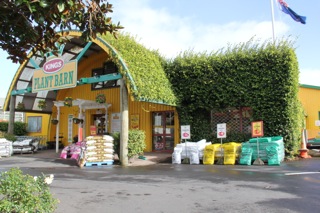
If I noted any negative, it’s that all the centers are so equal in selection, quality and display, it’s hard to distinguish them. One retailer I talked to admitted it was challenging to differentiate, because it’s a small country and there are few growers, and they all tend to sell the same products to everyone. Only the country’s two biggest growers, Zealandia Horticulture and T&M Nurseries, are exclusive to just one chain (Mitre 10 and Bunnings, respectively).
The one retail that stood out in my mind, visually at least, was the newest Palmers Store, dubbed Palmers Planet. Open for less than a season (making it New Zealand’s newest center), I was told it’s a copy of a Haskins Garden Centre in the UK. The other centers I visited were pretty run-of-the-mill in architecture, layout and merchandising. I wish I could have shown you some inspirational displays, but I didn’t spot any. But again, it’s the dead of the off-season here, and maybe come spring (which starts in September), the places will be brimming with ideas.
Prices
Pretty healthy, best as I could tell. The U.S. and NZ dollars aren't far off one another (at least after paying the exchange fee at the airport), and consumer prices felt high to me.
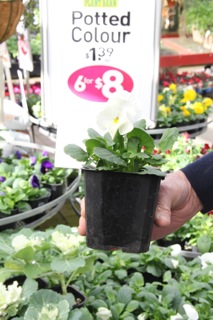
They were certainly healthy in the garden centres, with six packs going for $6.77. But 10-cm. (4-in.) potted color are low-balled by almost everyone, with "six for $8" quite common.
Cafe culture
One other thing to note about NZ garden centres is that, like the UK, they all have cafes, which seem to do a roaring trade. Every place we went, they were filled with customers enjoying a flat white, a snack or lunch. Even Mitre 10 has an upscale cafe (Bunnings had more of a coffee stand). Most often they’re operated by outside concessions, although at Palmer’s Planet, owner Richard Hackett said his brother runs his. “Why would you outsource your success?” he says. He calls it “the secret to the business” and says his café accounts for 20% to 30% of turnover, depending on season.
The consumer
I pictured New Zealand to be like Colorado, only bigger and with an accent. A population of health and fitness freaks biking and skiing and bungy jumping. Actually, it’s pretty true. This is a nation of people who love the outdoors (although I suspect they leave the bungy jumping to the tourists) and take every opportunity to enjoy it.
Which bodes well for the industry down here. With an ancestry of primarily English and Scottish, the gardening culture seems to be strong. One grower told me when I asked him how he got into the business, “My parents are mad gardeners.” I’d say they’re a generation or two closer to the gardening/farming culture than we are in the states. The 30-something growers I met said their friends seem keen on gardening, especially vegetables.
The growers
I’ll profile a few in a coming email, but the three I toured were an interesting mix. I mentioned Zealandia, one of the country’s biggies. They’ve got locations on both islands to cover every chain customer. Like big-box growers in the states, they primarily produce packs or “punnets” (called seedlings) and 10-cm pots (called potted color). Zealandia’s Auckland location cranks out 24,000 10-cm a day using a nice Visser PC-12 transplanter, a buffer belt and a fork truck. They use a funky tray that’s fairly standard width, but a full 720-mm (28+ in.) long. I was told it fits their home-grown racks and trucks perfectly; their retail customers actually changed their benching to accommodate it.
Steve Burton of Annton Nursery is an avid mountain runner, cyclist and hebe grower/selector with an eclectic collection of 70 varieties of flowering annuals and native plants at his nursery. His mom started growing orchids and natives as a hobby in 1980; now it’s a serious business, with a wide range of crops. One of his latest is blueberries starter plants for the blueberry industry. The 38-year-old is quotable, too. “We’re now selling to consumers, not gardeners,” he said as we started discussing business. “They’re driven by impulse, not knowledge.” All too true, Steve!
Rainbow Park and Rainbow Trees are owned by my hosts, the Tayler family. Rainbow Park does a combination of potted plants (mainly phalaenopsis, bromeliads, foliage and standard potted fare like begonias, mini roses and cyclamen) and what they call perennials, but what we’d call 6-in. premium annuals (New Guinea impatiens, dahlias and the like). They’re also doing some interesting vegetable offerings, such as six assorted lettuce in a large 6-count handle pack. (They sold 26,000 of them to Mitre 10, who retailed them for $10.99 and blew through them!)
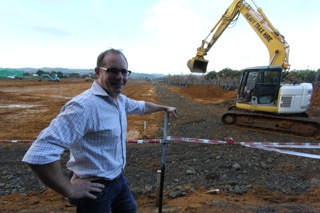
They’re also efficient, with Urbinati and Demtec pack and flat fillers and an Urbinati transplanter. Plus, that fancy new glasshouse about to go up, which Peter Tayler says will rival any in Europe. That's Andrew, above, checking out the progress.

A flat white, and keep to the left
One of the first things Peter Tayler asked me upon my arrival at Auckland Airport was if I’d like a “flat white.” I could only wonder why he was offering me a can of spray paint. Turns out a flat white is Kiwi for a cup of coffee with cream done in a style that’s something between a latte and a cappuccino. The flat white was invented in Australia and New Zealand in the 1980s. It’s tasty. I’ve had many since I got here.
Something I have to remember anytime I visit a country where they drive on the left is to also walk on the left. Quite naturally, one walks on the same side of the sidewalk as one drives—in America, that’s the right. But down here, they walk on the left, and so I dodged many a pedestrian until I got that right … er, I mean left.
“Quarter-acre pavlova paradise.”
Peter dropped this term on me the first day, as he explained what the average Kiwi wants from home life. I had to look it up on Wikipedia to see what it meant.
It comes from a famous book by Austin Mitchell, “The Half Gallon Quarter Acre Pavolova Paradise,” published in 1972, a satirical look at New Zealand life in the1960s. “Half gallon” refers to the standard flagon of beer then sold in New Zealand pubs; “quarter acre” referred to the suburban section of land on which most Kiwis built their homes; and “pavlova” is a popular Australian and New Zealand dessert—a cake-sized merengue topped with fruit and whipped cream, named after the Russian ballerina Anna Pavlova.
I took it to mean that folks here want a yard, and that means a garden. Although based on land prices and availability (real estate is doing very well here), it’s more like an eighth of an acre.
The world’s southernmost grower
Tuesday, we flew to Queenstown where the conference was being held. It looked like we were landing in the middle of the Alps or the Rockies. This is the New Zealand you see pictures of. They’d had a massive snow dump the weekend before, which bodes well for their annual Winter Festival, which was going on. Everywhere on the streets folks were carrying skis and snowboards toward shuttle buses.
We didn’t have time for nursery visits here, but at the conference, I met a young guy named Nathan Piggott, who turned out to be general manager of the world’s southernmost nursery, Evandale Gardens, in the city of Invercargill. He produces flower and vegetable seedlings—their term for small multi-cell packs (“punnets”), generally sold green with a tag. He’s got 5 acres of greenhouse, 5 acres of protected growing area and 4 acres of open production.
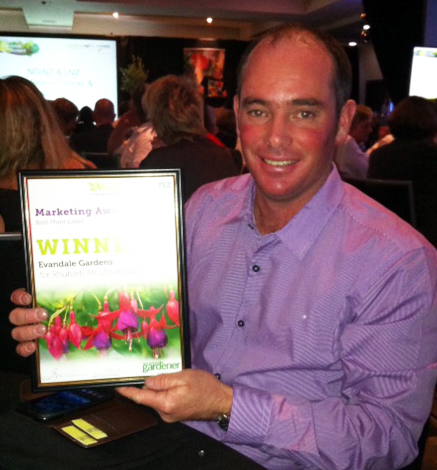
As the southernmost nursery, I pictured something rugged and barren, with crashing waves and gale-force winds, but Wikipedia describes Invercargill more like the British Isles, climate-wise. With a population of 53,000, it’s hardly desolate, and the region has some of New Zealand’s richest farmland. And while it sounds like the bottom of the earth, it turns out to be latitude 46.42 S—the equivalent of the border between Oregon and Washington (46 N). Yet other than the very southern tip of South America, 46 S only touches ocean.
Nathan’s biggest worry down there? Hail. It can and does hail at the drop of a hat. His protected growing area has wood frames that can hold poly sheeting that they pull over the crop any time there’s a threat of hail.
Oh, props to Nathan! At the conference award banquet, he won the Best Plant Label Award for his rhubarb Moulin Rouge. So I guess he’s also the southernmost grower to earn a marketing award.

NZ development
There seems to be loads of open land here, even close to the big city of Auckland, which is why I found it interesting that the country’s planners are debating whether to have future residential housing development to go outward, creating new suburbs, or upward, creating new high-rises. And the tide seems to be toward up, which will certainly impact landscaping and gardening.
On the surface, there wouldn’t seem to be a pressing need to worry about overdevelopment. But then I find out that the country has just one main highway, State Highway 1, is just two lanes for most of its 1,272 miles. Even around Auckland, it’s only four lanes for short sections, I’m told. Meaning any development of new suburban neighborhoods for commuters would require massive transportation infrastructure development—either more lanes or a mass transit scheme.
Well, that’s a brief taste of what I’ve picked up during my week here. I’ll share a few more thoughts and details next time (and maybe even video of my jet boat ride—hey, it’s all part of my research).
If you’ve got questions, let me know, and if I can’t answer, I now know the friendly folks who can. You can email me HERE.
Next time, from Chicagoland ...

Chris Beytes
Editor & Publisher
GrowerTalks and Green Profit
This e-mail received by 24,751 loyal readers!
Thanks to my loyal sponsors, who help me reach the 24,751 readers of Acres Online in 68 countries! Want to be one (a sponsor, that is)? Give Paul Black a shout and he'll hook you up.